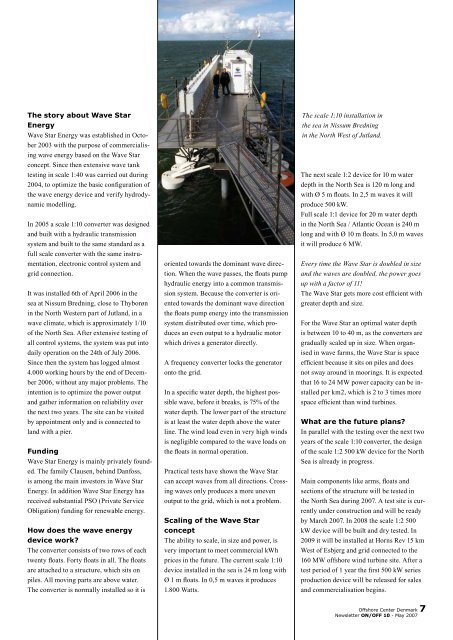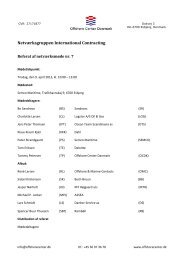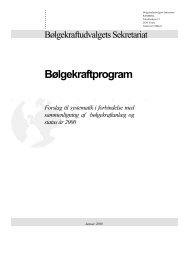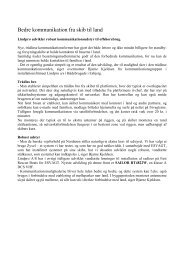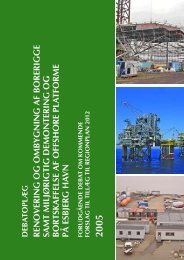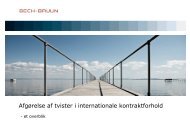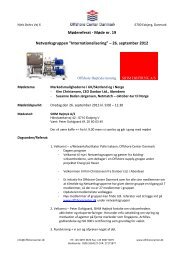Create successful ePaper yourself
Turn your PDF publications into a flip-book with our unique Google optimized e-Paper software.
The story about Wave Star<br />
Energy<br />
Wave Star Energy was established in October<br />
2003 with the purpose of commercialising<br />
wave energy based on the Wave Star<br />
concept. Since then extensive wave tank<br />
testing in scale 1:40 was carried out during<br />
2004, to optimize the basic configuration of<br />
the wave energy device and verify hydrodynamic<br />
modelling.<br />
In 2005 a scale 1:10 converter was designed<br />
and built with a hydraulic transmission<br />
system and built to the same standard as a<br />
full scale converter with the same instrumentation,<br />
electronic control system and<br />
grid connection.<br />
It was installed 6th of April 2006 in the<br />
sea at Nissum Bredning, close to Thyborøn<br />
in the North Western part of Jutland, in a<br />
wave climate, which is approximately 1/10<br />
of the North Sea. After extensive testing of<br />
all control systems, the system was put into<br />
daily operation on the 24th of July 2006.<br />
Since then the system has logged almost<br />
4.000 working hours by the end of December<br />
2006, without any major problems. The<br />
intention is to optimize the power output<br />
and gather information on reliability over<br />
the next two years. The site can be visited<br />
by appointment only and is connected to<br />
land with a pier.<br />
Funding<br />
Wave Star Energy is mainly privately founded.<br />
The family Clausen, behind Danfoss,<br />
is among the main investors in Wave Star<br />
Energy. In addition Wave Star Energy has<br />
received substantial PSO (Private Service<br />
Obligation) funding for renewable energy.<br />
How does the wave energy<br />
device work?<br />
The converter consists of two rows of each<br />
twenty floats. Forty floats in all. The floats<br />
are attached to a structure, which sits on<br />
piles. All moving parts are above water.<br />
The converter is normally installed so it is<br />
oriented towards the dominant wave direction.<br />
When the wave passes, the floats pump<br />
hydraulic energy into a common transmission<br />
system. Because the converter is oriented<br />
towards the dominant wave direction<br />
the floats pump energy into the transmission<br />
system distributed over time, which produces<br />
an even output to a hydraulic motor<br />
which drives a generator directly.<br />
A frequency converter locks the generator<br />
onto the grid.<br />
In a specific water depth, the highest possible<br />
wave, before it breaks, is 75% of the<br />
water depth. The lower part of the structure<br />
is at least the water depth above the water<br />
line. The wind load even in very high winds<br />
is negligible compared to the wave loads on<br />
the floats in normal operation.<br />
Practical tests have shown the Wave Star<br />
can accept waves from all directions. Crossing<br />
waves only produces a more uneven<br />
output to the grid, which is not a problem.<br />
Scaling of the Wave Star<br />
concept<br />
The ability to scale, in size and power, is<br />
very important to meet commercial kWh<br />
prices in the future. The current scale 1:10<br />
device installed in the sea is 24 m long with<br />
Ø 1 m floats. In 0,5 m waves it produces<br />
1.800 Watts.<br />
The scale 1:10 installation in<br />
the sea in Nissum Bredning<br />
in the North West of Jutland.<br />
The next scale 1:2 device for 10 m water<br />
depth in the North Sea is 120 m long and<br />
with Ø 5 m floats. In 2,5 m waves it will<br />
produce 500 kW.<br />
Full scale 1:1 device for 20 m water depth<br />
in the North Sea / Atlantic Ocean is 240 m<br />
long and with Ø 10 m floats. In 5,0 m waves<br />
it will produce 6 MW.<br />
Every time the Wave Star is doubled in size<br />
and the waves are doubled, the power goes<br />
up with a factor of 11!<br />
The Wave Star gets more cost efficient with<br />
greater depth and size.<br />
For the Wave Star an optimal water depth<br />
is between 10 to 40 m, as the converters are<br />
gradually scaled up in size. When organised<br />
in wave farms, the Wave Star is space<br />
efficient because it sits on piles and does<br />
not sway around in moorings. It is expected<br />
that 16 to 24 MW power capacity can be installed<br />
per km2, which is 2 to 3 times more<br />
space efficient than wind turbines.<br />
What are the future plans?<br />
In parallel with the testing over the next two<br />
years of the scale 1:10 converter, the design<br />
of the scale 1:2 500 kW device for the North<br />
Sea is already in progress.<br />
Main components like arms, floats and<br />
sections of the structure will be tested in<br />
the North Sea during 2007. A test site is currently<br />
under construction and will be ready<br />
by March 2007. In 2008 the scale 1:2 500<br />
kW device will be built and dry tested. In<br />
2009 it will be installed at Horns Rev 15 km<br />
West of Esbjerg and grid connected to the<br />
160 MW offshore wind turbine site. After a<br />
test period of 1 year the first 500 kW series<br />
production device will be released for sales<br />
and commercialisation begins.<br />
<strong>Offshore</strong> <strong>Center</strong> Denmark 7<br />
Newsletter <strong>ON</strong>/<strong>OFF</strong> 10 - May 2007


